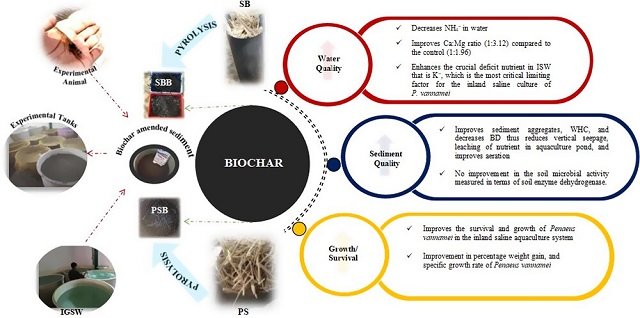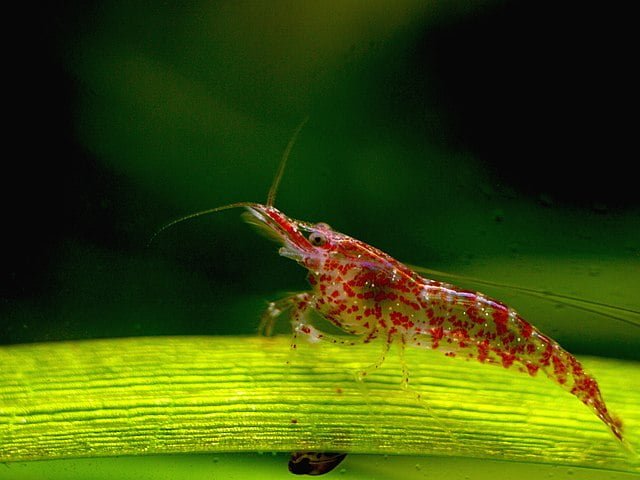In many parts of the world, agricultural lands are facing salinization. Aquaculture with brackish water has been identified as one of the main causes of salinization of agricultural lands.
Biochar has shown potential to remediate a range of agricultural problems; however, studies related to the use of biochar in aquaculture are limited.
Researchers from ICAR-Central Institute of Fisheries Education and Bihar Animal Sciences University studied the effects of biochar-modified sediment (9 t/ha) on the overall growth performance and physiological responses of Litopenaeus vannamei raised in saline water.
They conducted a 49-day experiment to evaluate the effects of sugarcane bagasse biochar (SBB) and activated sugarcane bagasse biochar (A-SBB) on water and sediment quality, as well as the growth and health status of vannamei shrimp.
Use of biochar
Biochar can be used in a large number of applications, ranging from heat production to soil remediation. However, the properties of carbonized biomass depend on the raw material and process conditions.
Agricultural waste and municipal wastewater sludge, among others, can be used as inputs for biochar production.
Biochar has been used for soil remediation and improvement, carbon sequestration, composting of organic solid waste, water and wastewater decontamination, catalyst and activator, electrode materials, and electrode modifier.
Water quality
According to the study, water quality parameter results showed a significant increase in K+ and Mg++ with a reduction in ammonia value in the biochar-treated groups.
Stay Always Informed
Join our communities to instantly receive the most important news, reports, and analysis from the aquaculture industry.
Among sediment properties, there was a substantially higher water retention capacity, soil organic carbon, pH, and cation exchange capacity in the biochar-added treatments, compared to the control.
Shrimp growth
“The growth parameters of vannamei shrimp showed a significant increase in weight gain percentage and a reduction in feed conversion ratio in the biochar-treated groups,” the study reports.
In addition, the activity of digestive enzymes (protease and amylase), metabolic enzymes (AST, ALT in the hepatopancreas), and oxidative stress enzymes (SOD in gills and hepatopancreas; CAT in gills) were significantly higher in the biochar-modified treatment groups.
Conclusion
“The results of the present study revealed that biochar-modified sediment has the potential to improve vital water and sediment parameters, physiological profiles, and growth of juvenile L. vannamei raised in saline water; however, further research is needed to demonstrate this under normal culture conditions,” they conclude.
Contact
Saurav Kumar
AEHM Division, ICAR-Central Institute of Fisheries Education, Versova,
Mumbai, Maharashtra, India
saurav@cife.edu.in
Reference:
Jateen, S., Bharti, V.S., Prakash, S. et al. Sugarcane bagasse biochar-amended sediment improves growth, survival, and physiological profiles of white-leg shrimp, Litopenaeus vannamei (Boone, 1931) reared in inland saline water. Aquacult Int (2023). https://doi.org/10.1007/s10499-023-01077-9
Editor at the digital magazine AquaHoy. He holds a degree in Aquaculture Biology from the National University of Santa (UNS) and a Master’s degree in Science and Innovation Management from the Polytechnic University of Valencia, with postgraduate diplomas in Business Innovation and Innovation Management. He possesses extensive experience in the aquaculture and fisheries sector, having led the Fisheries Innovation Unit of the National Program for Innovation in Fisheries and Aquaculture (PNIPA). He has served as a senior consultant in technology watch, an innovation project formulator and advisor, and a lecturer at UNS. He is a member of the Peruvian College of Biologists and was recognized by the World Aquaculture Society (WAS) in 2016 for his contribution to aquaculture.




